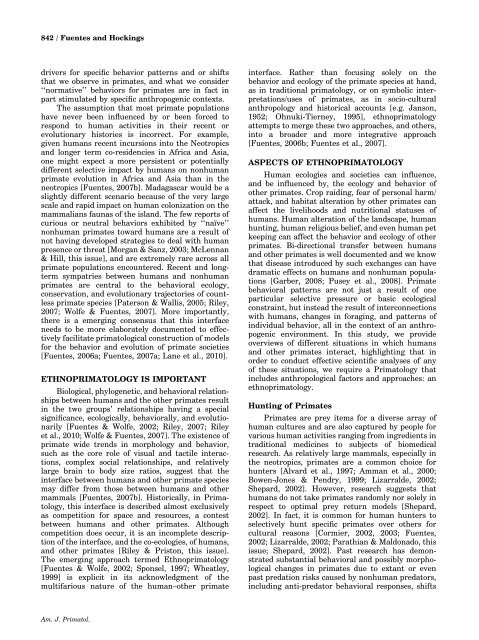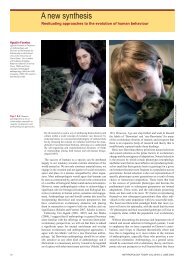The ethnoprimatological approach in primatology - Agustin Fuentes ...
The ethnoprimatological approach in primatology - Agustin Fuentes ...
The ethnoprimatological approach in primatology - Agustin Fuentes ...
Create successful ePaper yourself
Turn your PDF publications into a flip-book with our unique Google optimized e-Paper software.
842 / <strong>Fuentes</strong> and Hock<strong>in</strong>gs<br />
drivers for specific behavior patterns and or shifts<br />
that we observe <strong>in</strong> primates, and what we consider<br />
‘‘normative’’ behaviors for primates are <strong>in</strong> fact <strong>in</strong><br />
part stimulated by specific anthropogenic contexts.<br />
<strong>The</strong> assumption that most primate populations<br />
have never been <strong>in</strong>fluenced by or been forced to<br />
respond to human activities <strong>in</strong> their recent or<br />
evolutionary histories is <strong>in</strong>correct. For example,<br />
given humans recent <strong>in</strong>cursions <strong>in</strong>to the Neotropics<br />
and longer term co-residencies <strong>in</strong> Africa and Asia,<br />
one might expect a more persistent or potentially<br />
different selective impact by humans on nonhuman<br />
primate evolution <strong>in</strong> Africa and Asia than <strong>in</strong> the<br />
neotropics [<strong>Fuentes</strong>, 2007b]. Madagascar would be a<br />
slightly different scenario because of the very large<br />
scale and rapid impact on human colonization on the<br />
mammalians faunas of the island. <strong>The</strong> few reports of<br />
curious or neutral behaviors exhibited by ‘‘naïve’’<br />
nonhuman primates toward humans are a result of<br />
not hav<strong>in</strong>g developed strategies to deal with human<br />
presence or threat [Morgan & Sanz, 2003; McLennan<br />
& Hill, this issue], and are extremely rare across all<br />
primate populations encountered. Recent and longterm<br />
sympatries between humans and nonhuman<br />
primates are central to the behavioral ecology,<br />
conservation, and evolutionary trajectories of countless<br />
primate species [Paterson & Wallis, 2005; Riley,<br />
2007; Wolfe & <strong>Fuentes</strong>, 2007]. More importantly,<br />
there is a emerg<strong>in</strong>g consensus that this <strong>in</strong>terface<br />
needs to be more elaborately documented to effectively<br />
facilitate primatological construction of models<br />
for the behavior and evolution of primate societies<br />
[<strong>Fuentes</strong>, 2006a; <strong>Fuentes</strong>, 2007a; Lane et al., 2010].<br />
ETHNOPRIMATOLOGY IS IMPORTANT<br />
Biological, phylogenetic, and behavioral relationships<br />
between humans and the other primates result<br />
<strong>in</strong> the two groups’ relationships hav<strong>in</strong>g a special<br />
significance, ecologically, behaviorally, and evolutionarily<br />
[<strong>Fuentes</strong> & Wolfe, 2002; Riley, 2007; Riley<br />
et al., 2010; Wolfe & <strong>Fuentes</strong>, 2007]. <strong>The</strong> existence of<br />
primate wide trends <strong>in</strong> morphology and behavior,<br />
such as the core role of visual and tactile <strong>in</strong>teractions,<br />
complex social relationships, and relatively<br />
large bra<strong>in</strong> to body size ratios, suggest that the<br />
<strong>in</strong>terface between humans and other primate species<br />
may differ from those between humans and other<br />
mammals [<strong>Fuentes</strong>, 2007b]. Historically, <strong>in</strong> Primatology,<br />
this <strong>in</strong>terface is described almost exclusively<br />
as competition for space and resources, a contest<br />
between humans and other primates. Although<br />
competition does occur, it is an <strong>in</strong>complete description<br />
of the <strong>in</strong>terface, and the co-ecologies, of humans,<br />
and other primates [Riley & Priston, this issue].<br />
<strong>The</strong> emerg<strong>in</strong>g <strong>approach</strong> termed Ethno<strong>primatology</strong><br />
[<strong>Fuentes</strong> & Wolfe, 2002; Sponsel, 1997; Wheatley,<br />
1999] is explicit <strong>in</strong> its acknowledgment of the<br />
multifarious nature of the human–other primate<br />
Am. J. Primatol.<br />
<strong>in</strong>terface. Rather than focus<strong>in</strong>g solely on the<br />
behavior and ecology of the primate species at hand,<br />
as <strong>in</strong> traditional <strong>primatology</strong>, or on symbolic <strong>in</strong>terpretations/uses<br />
of primates, as <strong>in</strong> socio-cultural<br />
anthropology and historical accounts [e.g. Janson,<br />
1952; Ohnuki-Tierney, 1995], ethno<strong>primatology</strong><br />
attempts to merge these two <strong>approach</strong>es, and others,<br />
<strong>in</strong>to a broader and more <strong>in</strong>tegrative <strong>approach</strong><br />
[<strong>Fuentes</strong>, 2006b; <strong>Fuentes</strong> et al., 2007].<br />
ASPECTS OF ETHNOPRIMATOLOGY<br />
Human ecologies and societies can <strong>in</strong>fluence,<br />
and be <strong>in</strong>fluenced by, the ecology and behavior of<br />
other primates. Crop raid<strong>in</strong>g, fear of personal harm/<br />
attack, and habitat alteration by other primates can<br />
affect the livelihoods and nutritional statuses of<br />
humans. Human alteration of the landscape, human<br />
hunt<strong>in</strong>g, human religious belief, and even human pet<br />
keep<strong>in</strong>g can affect the behavior and ecology of other<br />
primates. Bi-directional transfer between humans<br />
and other primates is well documented and we know<br />
that disease <strong>in</strong>troduced by such exchanges can have<br />
dramatic effects on humans and nonhuman populations<br />
[Garber, 2008; Pusey et al., 2008]. Primate<br />
behavioral patterns are not just a result of one<br />
particular selective pressure or basic ecological<br />
constra<strong>in</strong>t, but <strong>in</strong>stead the result of <strong>in</strong>terconnections<br />
with humans, changes <strong>in</strong> forag<strong>in</strong>g, and patterns of<br />
<strong>in</strong>dividual behavior, all <strong>in</strong> the context of an anthropogenic<br />
environment. In this study, we provide<br />
overviews of different situations <strong>in</strong> which humans<br />
and other primates <strong>in</strong>teract, highlight<strong>in</strong>g that <strong>in</strong><br />
order to conduct effective scientific analyses of any<br />
of these situations, we require a Primatology that<br />
<strong>in</strong>cludes anthropological factors and <strong>approach</strong>es: an<br />
ethno<strong>primatology</strong>.<br />
Hunt<strong>in</strong>g of Primates<br />
Primates are prey items for a diverse array of<br />
human cultures and are also captured by people for<br />
various human activities rang<strong>in</strong>g from <strong>in</strong>gredients <strong>in</strong><br />
traditional medic<strong>in</strong>es to subjects of biomedical<br />
research. As relatively large mammals, especially <strong>in</strong><br />
the neotropics, primates are a common choice for<br />
hunters [Alvard et al., 1997; Amman et al., 2000;<br />
Bowen-Jones & Pendry, 1999; Lizarralde, 2002;<br />
Shepard, 2002]. However, research suggests that<br />
humans do not take primates randomly nor solely <strong>in</strong><br />
respect to optimal prey return models [Shepard,<br />
2002]. In fact, it is common for human hunters to<br />
selectively hunt specific primates over others for<br />
cultural reasons [Cormier, 2002, 2003; <strong>Fuentes</strong>,<br />
2002; Lizarralde, 2002; Parathian & Maldonado, this<br />
issue; Shepard, 2002]. Past research has demonstrated<br />
substantial behavioral and possibly morphological<br />
changes <strong>in</strong> primates due to extant or even<br />
past predation risks caused by nonhuman predators,<br />
<strong>in</strong>clud<strong>in</strong>g anti-predator behavioral responses, shifts



